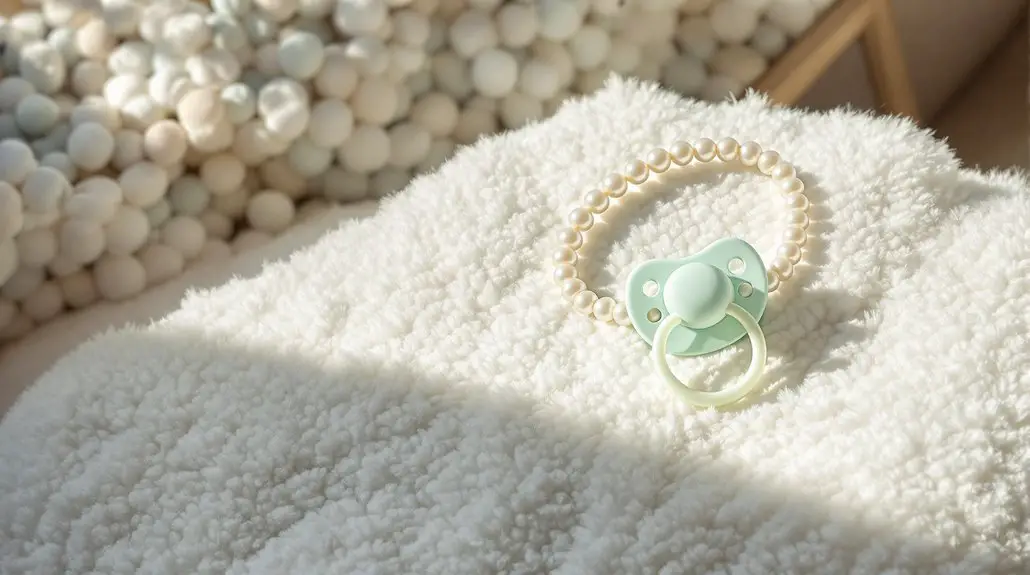11 Genius Ways to Soothe a Colicky Baby
We’ve all been there – standing in the nursery at 2 AM with a crying baby who just won’t settle down. Colic can test even the most patient parent’s nerves, leaving us exhausted and desperate for solutions. While there’s no magic cure for this challenging phase, we’ve discovered several proven techniques that can help soothe your little one and restore peace to your household.
From the surprising power of white noise to lesser-known holding positions, these methods have helped countless parents survive the colicky months. Let’s explore these practical strategies that could transform your nighttime routine and bring relief to both you and your baby.
The Power of White Noise
White noise comes through as a powerful ally for parents struggling with colicky babies. We’ve found that this simple sound technique effectively recreates the soothing environment of the womb, where babies were accustomed to constant background noise. Research shows it’s even more effective than swinging for reducing crying and extending sleep duration. Using a timer function helps parents avoid sound dependency in their infants. Household items like vacuum cleaners can provide similar calming effects.
Let’s look at how we can put this into practice. We recommend using fans, rain machines, or specialized white noise apps, keeping the volume below 60 decibels and positioning the source at least 20 inches from your baby’s sleeping area.
It’s crucial to monitor your little one’s response to ensure the noise isn’t causing distress.
White noise works by masking disruptive external sounds and creating a consistent sleep environment. We’ve seen it help babies fall asleep faster and stay asleep longer, which means better rest for the whole family.
When incorporated into a regular bedtime routine, it becomes a reliable sleep cue for your baby. Remember, while white noise is powerful, it works best as part of a comprehensive soothing approach, alongside other methods like gentle massage and cradling.
Swaddling for Sweet Dreams
Swaddling stands as one of the most effective techniques we’ve found for soothing colicky babies. By recreating the snug environment of the womb, we’re helping regulate our little one’s nervous system and reducing those intense crying episodes that come with colic. Episodes are especially challenging since they often occur during nighttime hours.
Let’s get the technique right: Start with a lightweight blanket in a diamond shape, folding the top corner down. Place your baby on their back, with their neck above the folded edge. Then wrap the left and right corners snugly across their chest, tucking them underneath. This gentle pressure helps release calming endorphins in your baby’s system.
We’ll want to ensure it’s secure but not too tight – those little hips need room to move naturally.
When we swaddle correctly, we’re doing more than just wrapping our baby. We’re reducing their startle reflex, maintaining their body temperature, and even helping with uncomfortable gas.
But remember, safety comes first: Always place swaddled babies on their backs, and stop swaddling once they show signs of rolling over, typically around 2-4 months. If you’re noticing your baby’s getting too warm, switch to a lighter blanket to prevent overheating.
Baby Massage Techniques

Along with swaddling, gentle massage offers another powerful way to comfort our colicky babies. Skin-to-skin contact during massage sessions creates a deep bonding experience.
Before starting, let’s consult our pediatrician and choose a baby-specific massage oil that we’ll warm between our hands. We’ll want to time these sessions at least 45 minutes after feeding, either in the morning or evening. These massages can help promote better sleep patterns in infants.
Let’s focus on proven stomach-soothing techniques. We’ll start with the clock method, imagining our baby’s belly as a clock face and moving our hands clockwise from the 7 o’clock position.
The ILY technique, where we trace these letters on the tummy, works wonders for gas relief. We can also try the water wheel, using our flat palm to scoop gently below the ribs.
For maximum benefit, we’ll combine these moves with leg exercises. The bicycle technique, where we gently push baby’s knees to the belly and stretch them out, helps release trapped gas.
We’ll know we’re doing it right when our little one stays relaxed and receptive. If they become stiff or distressed, we’ll pause and try again later.
Gentle Motion and Movement
Naturally, gentle motion provides one of the most effective ways to calm a colicky baby. We’ve found that consistent, rhythmic movement can help release trapped gas while mimicking the familiar sensation of being in the womb. Resting hands gently on your baby before starting any movement can help prepare them for the soothing experience. Since colicky episodes tend to peak in the evening, this is an especially important time to have motion-based solutions ready.
Whether you’re using a baby swing, rocking chair, or stroller, the key is maintaining steady, gentle motion without sudden stops or jarring movements.
To create a soothing environment through motion, try these proven methods:
- Place your baby in a secure swing or vibrating seat, ensuring they’re properly strapped in
- Take a calming car ride or stroller walk around the neighborhood
- Use a baby carrier while walking or doing gentle household tasks
- Rock together in a rocking chair while keeping your baby swaddled
When implementing any motion-based soothing technique, we always want to monitor our baby’s comfort level and adjust accordingly.
The combination of movement and rhythmic sounds, like those from a car engine or washing machine, can be particularly effective. Remember to keep motions slow and steady, as this helps your little one feel secure and may even encourage them to drift off to sleep.
Try Different Holding Positions

Discovering the right holding position can make a significant difference in soothing your colicky baby. Let’s explore four effective positions that we’ve found can help provide relief during those challenging moments.
The face-down position offers natural pressure relief by placing your baby’s tummy on your forearm while supporting their head. We’ll want to ensure their airway remains clear while using this hold. Parents can expect to spend at least 3 hours daily comforting their colicky infant through various holds. These holding sessions are most effective during the peak crying times that typically occur in the evening hours.
For a different approach, we can try the hip hold, which lets us keep baby close while walking or swaying – simply position them around your hips while supporting their back.
The shoulder hold is particularly useful for combining comfort with burping. We’ll place baby’s head on our shoulder while supporting their back and bottom, making sure they’re secure.
Finally, the upright position proves especially helpful after feeding. By sitting baby up with proper neck and chest support, we can prevent gas buildup and reduce air intake.
Each baby responds differently to various holds, so we’ll want to try these positions to find what works best. Remember to maintain proper support and adjust as needed to ensure your little one’s comfort and security.
Create a Calming Environment
Once you’ve found a comfortable holding position, creating a calming environment can further help soothe your colicky baby.
Let’s focus on setting up an atmosphere that mimics the familiar conditions of the womb, where your little one felt most secure and comfortable.
Start by creating a dark, quiet space using blackout curtains or sleep shades.
The symptoms typically peak in the evening, making a peaceful environment especially important during nighttime hours.
We’ve found that maintaining a consistent room temperature and eliminating distracting lights helps babies settle more easily.
Understanding that immature digestive systems can contribute to colic, a peaceful environment becomes even more crucial for helping your baby relax.
To create a soothing background, consider using white noise machines, fans, or even the sound of running water.
Here’s what we recommend for establishing a calming routine:
- Set up a white noise machine or fan to create consistent background sounds
- Keep the room temperature comfortable and use blackout curtains to control light
- Try gentle motion with a baby swing or rocking chair
- Place the baby near household appliances like washers or dishwashers for soothing mechanical sounds
Remember to always follow safe sleep practices by placing your baby on their back on a flat, firm surface.
Keep the sleep area free of loose bedding, pillows, and toys to ensure both comfort and safety while you work on soothing your colicky baby.
Pacifier Solutions

Comfort often comes in small packages, and pacifiers can be powerful tools for soothing colicky babies. These simple devices trigger a natural calming reflex through sucking motions, which can help reduce crying and even assist with digestive issues that may be causing your baby’s discomfort. Preterm infants may especially benefit from early pacifier introduction. Up to 75% of Western babies use pacifiers as a soothing aid.
We recommend introducing pacifiers at the right time to maximize their benefits. If you’re breastfeeding, wait until nursing is well-established (around one month) to prevent nipple confusion. For bottle-fed babies, you can start sooner.
When selecting a pacifier, choose a one-piece design to minimize choking risks, and ensure it’s the correct size for your baby’s age.
Let’s talk safety: Always keep pacifiers clean and sterile to prevent bacterial growth. While they’re excellent soothers and can reduce SIDS risk during sleep, don’t reinsert them if they fall out while your baby’s sleeping.
Also, be mindful that extended pacifier use beyond six months may increase ear infection risks. If your baby resists the pacifier, don’t force it – some babies simply prefer other soothing methods.
Remember to replace pacifiers regularly and inspect them for signs of wear.
Natural Remedies Worth Trying
While pacifiers offer one way to soothe your colicky baby, natural remedies can provide additional relief through gentle, time-tested methods. Research shows excessive crying periods can last 3 or more hours daily. Creating a calming atmosphere with dim lights and minimal noise can significantly reduce stress for colicky infants.
We’ve found that herbal solutions, like fennel and chamomile teas, can effectively calm your baby’s digestive system and reduce discomfort. When combined with physical therapy techniques, these natural approaches often deliver impressive results.
Let’s explore some of the most effective natural remedies you can try:
- Gripe water without alcohol can quickly ease gas and stomach discomfort, while gentle tummy massages with diluted lavender or chamomile essential oils help relax your baby.
- Probiotics and glutamine supplements, when approved by your pediatrician, may significantly reduce colic symptoms by supporting digestive health.
- Craniosacral therapy offers a gentle way to release tension in your baby’s head and neck area, promoting overall relaxation.
- Magnesium cream applied to your baby’s feet or tummy can help relax muscles naturally.
Remember to always warm your hands before massage and keep the room comfortably dim during these treatments.
We’ve seen these natural approaches work particularly well when combined with environmental adjustments like white noise and proper swaddling.
Skin-to-Skin Contact Benefits

The magic of skin-to-skin contact lies in its profound ability to soothe colicky babies through nature’s most basic connection. When we hold our crying infant chest-to-chest, we’re not just providing comfort – we’re activating powerful biological responses that can significantly reduce their distress.
Let’s explore why this works: skin-to-skin contact stabilizes your baby’s vital signs, regulating their heart rate, breathing, and core temperature. We’ve seen that babies who receive this intimate contact cry 12 times less than those who don’t. That’s because it naturally lowers their cortisol levels, reducing stress after uncomfortable episodes. Parents should aim for 20-minute minimum sessions during each skin-to-skin contact period. Using a comfortable rocking chair can enhance the calming experience for both parent and baby.
Beyond immediate soothing, this practice boosts your baby’s immune system by transferring beneficial bacteria from your skin to theirs.
It’s also remarkable for enhancing weight gain and promoting better feeding patterns, as it stimulates their natural feeding reflexes and improves digestion.
We recommend trying skin-to-skin contact whenever your baby becomes colicky. Both parents can participate in this soothing technique – simply place your bare-chested baby against your bare chest, covered with a light blanket.
The benefits extend beyond calming, creating deeper sleep patterns and fostering crucial emotional bonding that lasts well beyond the colicky phase.
The Car Ride Method
Many parents swear by the soothing power of car rides for calming their colicky babies. The combination of gentle motion and consistent engine noise can effectively lull a fussy infant to sleep, which has led to the development of various car ride simulation methods for indoor use.
While actual car rides can work wonders, we don’t recommend driving when you’re exhausted. Instead, consider these safer alternatives that mimic the car ride experience:
- Vibrating baby seats that create similar motion patterns
- White noise machines that replicate engine sounds
- Rocking chairs or gliders that provide rhythmic movement
- Baby swings with variable speed settings
We’ve found that the car ride method works best when combined with other soothing techniques like swaddling or skin-to-skin contact.
Though research shows mixed results about the effectiveness of car ride simulators compared to other methods, they’re worth trying as part of your soothing toolkit. Most colicky episodes typically resolve by 4-5 months of age, so remember that this challenging period is temporary.
Taking Care of Yourself

Caring for a colicky baby can drain even the most patient parent, making self-care a top priority. We need to remember that taking breaks isn’t selfish – it’s essential for maintaining our ability to provide the best care for our little ones.
When we’re feeling overwhelmed, let’s give ourselves permission to step away for 10-15 minutes. If possible, we should hand off responsibilities to a partner or trusted helper. Remember that 3 hours of crying each day peaks around 6 weeks of age. This common condition affects 10-26% of infants worldwide.
It’s crucial to build a support network, whether through local colic support groups or connecting with other parents who understand our challenges.
We must remind ourselves that colic is temporary and harmless once medical conditions are ruled out. Let’s focus on activities that help us decompress, such as taking a walk, enjoying a relaxing bath, or practicing meditation.
We shouldn’t hesitate to reach out to our pediatrician for guidance and reassurance when needed.
Most importantly, we need to practice self-compassion during this challenging phase. By acknowledging our feelings and actively managing our stress levels, we’ll be better equipped to handle crying episodes.
Conclusion
Dealing with colic can feel like navigating a storm without a compass, but we’ve got proven ways to weather it together. We’ve explored everything from white noise to massage techniques, giving us a toolbox of solutions to try. Let’s remember that every baby’s different, and what works today might not work tomorrow. Most importantly, we’ll take care of ourselves while helping our little ones find comfort and calm.







